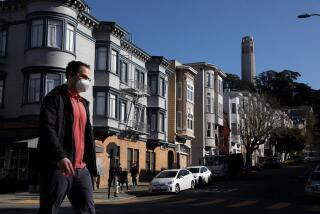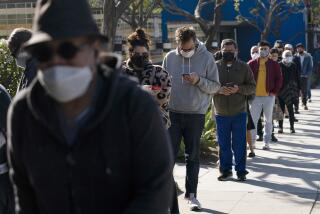Coronavirus cases in California increasing: Here’s what you need to know

California now has six confirmed cases of the new strain of coronavirus. Health officials expect that number to grow but have said the threat to the general public remains low.
The Department of Defense said that it has agreed to house up to 1,000 people who may need to be quarantined upon arrival from overseas travel because of the coronavirus and that two of the four facilities selected are in California.
Travis Air Force Base in Solano County and Marine Corps Air Station Miramar in San Diego County are the two California sites that were selected, said Lt. Col. Chris Mitchell, a Pentagon spokesman. The others are Lackland Air Force Base in Texas and the 168th Regiment Regional Training Institute in Colorado.
On Friday, the Centers for Disease Control and Prevention ordered a quarantine of all 195 people from Wuhan, China, who were evacuated to March Air Reserve Base in Riverside County after fleeing the coronavirus outbreak. The quarantine will last 14 days — the incubation period for the virus — from when the plane left China, CDC officials said. The mandatory quarantine is the CDC’s first in more than 50 years.
President Trump declared a public health emergency over the coronavirus, imposing restrictions on travel to the U.S. from China.
Here is what we know about the confirmed cases in California:
San Benito County
On Sunday, health officials said that two patients in the Bay Area were a married couple and that the husband had recently returned from Wuhan.
The husband, 57, passed the virus on to his wife, also 57. The couple had not left their home since the husband returned from China. The county’s public health department said the two patients have not been hospitalized and remain isolated in their home.
“We continue to monitor the situation closely to protect the health of San Benito County residents and limit the spread of this virus,” said Dr. Marty Fenstersheib, the county’s health officer.
Santa Clara County
Last week, officials announced a man had become sick after a trip to China.
A second case involves a woman who arrived in the U.S. on Jan. 23 to visit family, officials said. She has stayed home since she arrived, except for two trips to seek outpatient medical care. She has been regularly monitored and was never sick enough to be hospitalized.
Family members have also been isolated, which means they do not leave the house, even to buy groceries, officials said. The county health department is providing food and other necessary items for the family.
“I understand that people are concerned, but based on what we know today, the risk to the general public remains low,” said Dr. Sara Cody, Santa Clara County’s health officer. “A second case is not unexpected. With our large population and the amount of travel to China for both personal and business reasons, we will likely see more cases.”
Los Angeles County
The infected person was a returning traveler from Wuhan.
“The infected person presented themselves immediately for care at LAX airport once they noticed they weren’t feeling well,” L.A. County public health director Dr. Barbara Ferrer said.
Orange County
The Orange County patient is in good condition and is in isolation at a hospital, health officials said.
In both counties, health authorities are following up with anyone who has had close contact with the patients, but they noted that casual contact with an infected person — such as visiting the same grocery store or movie theater — carries only “minimal risk of developing infection.”
“The risk of local transmission remains low,” officials said last week.
Coronavirus fears prompt hoaxes and misinformation
Basic facts about the virus
Here are some basic facts from the CDC about coronavirus:
Symptoms: Reported illnesses have included people with little to no symptoms and people being severely ill and dying. Symptoms can include:
- Fever
- Cough
- Shortness of breath
Prevention: There is currently no vaccine. The best way to prevent infection is to avoid being exposed to this virus. However, as a reminder, CDC always recommends everyday preventive actions to help avoid the spread of respiratory viruses, including:
- Wash your hands often with soap and water for at least 20 seconds, especially after going to the bathroom; before eating; and after blowing your nose, coughing or sneezing.
- If soap and water are not readily available, use an alcohol-based hand sanitizer with at least 60% alcohol. Always wash hands with soap and water if hands are visibly dirty.
- Avoid touching your eyes, nose, and mouth with unwashed hands.
- Avoid close contact with people who are sick.
- Stay home when you are sick.
- Cover your cough or sneeze with a tissue, then throw the tissue in the trash.
- Clean and disinfect frequently touched objects and surfaces using a regular household cleaning spray or wipe.
Getting checked out: If you develop a fever and symptoms of respiratory illness, such as cough or shortness of breath, within 14 days after travel from China, you should call ahead to a healthcare professional and mention your recent travel or close contact.
If you have had close contact with someone showing these symptoms who has recently traveled from this area, you should call ahead to a healthcare professional and mention your close contact and their recent travel.
More to Read
Start your day right
Sign up for Essential California for news, features and recommendations from the L.A. Times and beyond in your inbox six days a week.
You may occasionally receive promotional content from the Los Angeles Times.










